Global Poverty Situation and Economic Analysis
【Overview】

He who shows mercy to the poor lends to the Lord, and the Lord will repay him for his good deed. (Proverbs 19:17)
No society can be prosperous and happy in which the majority of its people live in poverty and misery. (Adam Smith, 1776)
Social security can directly reduce poverty and make growth more "poor-biased." (OECD, 2010)
Our ideal is a world free from poverty. (World Bank Mission Statement)
1. The meaning of poverty
This article intends to introduce the universal poverty problem, what policies and measures should be taken internationally and nationally to reduce poverty, and how we can participate in poverty alleviation.
Poverty is a major social problem in all countries, and its severity depends on the country's level of economic development. Even rich and powerful advanced countries still have many poor people, including homeless people, who are the most vulnerable groups in society. All countries, whether developed or developing, attach great importance to their own poverty problems and are committed to reducing poverty.
Governments of various countries and international organizations such as the World Bank and the United Nations Development Program have poverty alleviation policies and plans. However, after half a century of hard work, there are still many people living in poverty, especially in less developed regions and countries. Sub-Saharan Africa and South Asia have the highest proportion of poor people. Poverty alleviation remains the future focus of various countries and international organizations.
There are many reasons for poverty. Firstly, there is insufficient production to feed everyone. Secondly, income and wealth are unevenly distributed. The rich enjoy luxury while the poor have no place to stand. In advanced countries, since the Industrial Revolution in the 18th century, mass production in factories, advances in agricultural technology, and increased food production have led to a significant increase in the wealth of ordinary people over a period of time. Coupled with the social welfare system, most people can enjoy a life of adequate food and clothing. , but there are still a small number of people living in poverty.
Most of the developing countries, especially the poorer ones, live with insufficient food and clothing, and it is still common for the entire country to be impoverished. No wonder some people say that the most important reason for people's poverty is living in poor countries, followed by living in rural areas. To get rid of poverty, a country needs economic growth, but the fruits of growth should be shared by all people, rather than falling into the pockets of a few. If everyone's income increases, absolute income can be increased and the proportion of poor people can be reduced.
Poverty can become a vicious cycle, or so-called poverty trap, in which poor people are trapped in persistent poverty and hunger, and it is difficult to get out of the situation unless they get help from others. Therefore, supporting the poor and helping the poor to become self-reliant and escape poverty is indeed a cause of concern.
2. Definition of poverty and poverty alleviation policies
The Chinese word "poverty" refers to extreme inadequacy, poverty and lack of money. Poverty in English also covers many aspects, generally referring to the state of lacking a certain amount of money or material things. Absolute poverty refers to the lack of basic necessities of life, including food, water, sanitation, clothing, housing, medical services and education. Relative poverty refers to uneven economic distribution. The income of the population is lower than a certain standard ratio. It can usually be estimated by some indicators, such as the Gini coefficient. The higher the index, the more uneven the income distribution. Can be used as an international comparison.
The first thing any poverty alleviation policy or measure faces is the identification of poor families, that is, the quantitative definition of poverty, in order to have a basis for determining relief standards. Usually, the poverty line (poverty) can only be established based on family income and the expenses required to maintain basic living. line). Since each country has different levels of economic development and price levels, most poverty lines are set by themselves.
The international community generally adopts the World Bank's estimated definition of "absolute poverty" and uses the inability to meet basic subsistence needs (living expenses or income per person per day) as the poverty line. The current standard is an income of US$1.25 per day (based on the 2005 purchasing power parity method). estimated to facilitate international comparison). Less than US$1.25 is extreme poverty; US$2 to US$5 is moderate poverty; if the average real income per person per day in the country or region is less than US$1.25, the gap between them is poverty Poverty gap, for example, if the income per person per day is US$0.87, the poverty gap is US$0.38. This indicator can be used as a government subsidy program to help the "absolutely poor" population at least reach the level of "extreme poverty".
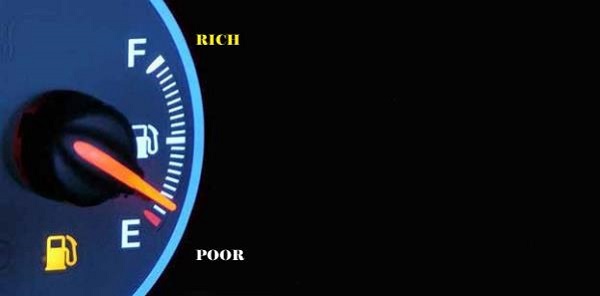
不過這種貧窮線的指標爭議性頗大,因為許多國家對貧窮的定義不同,因而自訂國家貧窮線作為補助標準,並隨通貨膨脹調整。例如美國,2010年絕對貧窮線是每人每天15.15美元或一家四口每年22,000美元(標準例子),2013年為一家四口每年23,492美元。1993年貧窮率逐年下降,到2000年的11.3%之後又逐年升高;2010年有15.1%的人口屬於貧窮人口。1 最近報導,2011年美國貧窮人口達4千6百20萬人,2013年為4千6百50萬人,佔總人口比率都約在15%。2 可見連先進國家如美國還是有很多貧窮人口。
臺灣原先也沒有明確的貧窮線定義,用低收入戶與中低收入戶作為社會救助的主要對象,採用最低生活費的標準來核定救助金額。從1997年開始統一採用平均每人可支配收入中位數60%來計算低收入人口。2011年修改社會救助法,增加中低收入補助。2012年核定中低及低收入人數為63萬9千餘人,2013年增加到69萬6千餘人,佔總人口只約3%。2014年起,貧窮線在修法後首次調整,在臺灣地區由新臺幣10,244元調高到10,869元。預估2014年的中低收入戶及人數會再上升到約75萬,佔總人口3.2%。3
中國的貧困線被設定在日收入人民幣6.3元,主要貧窮人口在農村。根據中國國家統計局2013年2月發表的數據,2012年有9899萬農村居民生活在貧困線以下(約為中國總人口的10.2%),比2011年的數字少了2339萬人,是個引人注目的進步速度。4
3. International efforts to alleviate poverty
減少貧窮是許多國家及國際機構,如聯合國及其附屬機構世界銀行的主要目標;世界銀行總部的石碑上甚至刻有其使命宣言:「我們的理想是一個免於貧窮的世界。」5 經過多年的來回討論,2000年9月8日,聯合國在189個會員國代表或元首參加的高峰會議上,發表千禧年發展目標及指標宣言(UN Millennium Development Goals and Targets, 即MDGs)。MDGs確定在新的千禧世紀2015年以前,達到八項減少貧窮的目標,每一項目標底下又訂定若干具體指標(targets,共計18個指標)及衡量指標(indicators,暫定48種)。八項目標分別為:消弭極端貧窮及飢餓、普及小學教育、促進兩性平等及增加婦女權力、降低兒童死亡率、增進產婦健康、對抗愛滋病毒、瘧疾及其他疾病、確保環境的永續經營能力,以及促進全球發展夥伴關係。
MDGs首要目標是:在2015年之前,使極端貧窮的人口比率減少一半。其他七項目標與減少貧窮也有相關。根據世界銀行估計,1990年全球極端貧窮人口有19.1億人,絕大多數在發展中國家,佔總人口的43.1%,以非洲撒哈拉沙漠以南、南亞及東南亞(中國)最多(見圖1)。經過努力之後,2008年降到22.7%的新低點;2010年估計已經降到20.6%,比千禧年目標提早五年達成。6 1990至2010期間約有6億6300萬人脫離極端貧窮,但到2010年仍有12億2000萬人處在極端貧窮中,佔發展中國家人口約21%。7
Figure 1: The World Bank estimates the declining trend in the ratio of extreme poverty to the total population.
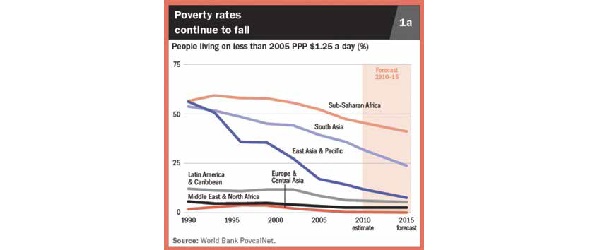
Source: World Bank: World Development Indicators, 2013, p2.
另外一種統計顯示極端貧窮人口比率下跌,大多靠中國大陸的改善(見圖2)。世界極端貧窮的人口從1981年到2010年減少7億2100萬,但大多數的減幅來自中國大陸,從1981年的8億3500萬到2010年的1億5500萬(減幅6億8千萬);其他地區減幅較少,低收入國家甚至從2億4900萬增加到3億5200萬。以人口比率來看,中國大陸的比率從1981年的84%降到2010年的12%。印度從60%降到33%,低收入國家從63%到44%(但由於人口成長率較高,絕對極端貧窮的人口數反而增加)。8 以個別國家而言,112個發展中國家,有59個國家將會達到貧窮減半的目標。如何協助這些窮人脫離貧困仍是全世界的挑戰。
2013年4月世界銀行制定兩項新目標,第一是希望在未來二十年消弭極端貧窮,其具體指標是在2030年之前,全世界只靠一天基本生活費1.25美元維生的人口不超過3%。第二是世界銀行推展分享繁榮的策略,希望每個國家收入落在最低的40%人口,其收入在未來五年內能持續增加。9
Figure 2: Extreme poverty rates have fallen, but many people remain in extreme poverty
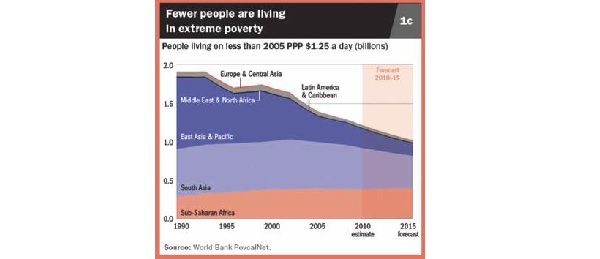
Source: World Bank: World Development Indicators, 2013, p2.
Figure 3: World national income distribution in 1989 (represented by GDP)
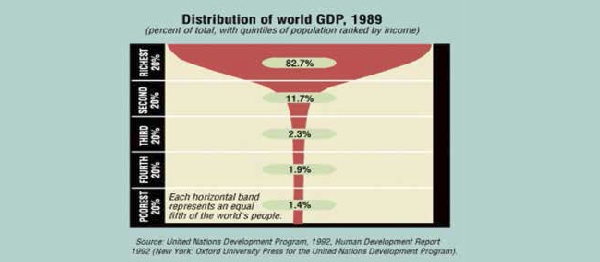
The World Bank's first goal is to reduce the number of extremely poor people from 16% to 3%. This is an arduous project, especially in sub-Saharan Africa where the extreme poor population is about 400 million, and the extreme poverty population is as high as 500 million. of South Asia. Assuming that the world population is 8.5 billion in 2030, the number of extremely poor people cannot exceed 250 million. By then, the poor will still be concentrated in these two regions, each accounting for 40%.
4. Poverty and income distribution
Improving income distribution and increasing the income of the poorest people is the World Bank's second goal. If a country wants to reduce its poverty population, in addition to its economic growth rate, it also depends on its income distribution. If the fruits of economic growth are taken away by the rich, the poor still do not get much benefit. Income distribution, and even wealth distribution, therefore becomes important in reducing poverty.
In the early stages of development in advanced countries, real wages (after excluding inflation) increased and the government focused on the relative equality of income distribution, which created the ability of the middle class to consume large amounts, further driving more economic growth. However, in recent years, advanced countries have also faced increasingly severe problems of uneven income distribution and wealth distribution.
There are two types of income distribution. One is international income distribution, which means that rich and powerful countries have high incomes and poor countries have low incomes, as shown in Figure 3, resulting in a champagne glass-like income distribution (estimated based on gross domestic product, that is, Gross Domestic Product , GDP); a wealthy country that only accounts for 20% of the world's population has a national income of more than 80%.
The other is the distribution of income within a country. Every country has uneven income distribution. For the sake of economic justice and social fairness, most countries hope to narrow the gap in income distribution. However, in recent years, many countries have faced worsening income distribution problems.

▲The uneven distribution of wealth is more serious than the uneven distribution of income. How to create more wealth and benefit the poor is an important issue at present.
例如美國,經濟學家估計,1980年以來收入分配不均大幅惡化,薪資增加遲緩,甚至下跌。最高收入達前1%的人口佔全國家庭總收入的比率從1980年的10%增加到2011年的20%,達歷史新高,2012年仍達19.3%。2012年,最高收入的1%人口其收入增加率為19.6%,而其他99%的人口其收入只增加1%。10
From 2009 to 2012, the household income of the top 1% population in the United States increased by 31.4%, while that of low-income earners only increased by 0.4%. The real income gap between the richest people and the poorest and middle-income people in various regions across the country has widened. The income of the richest people has grown rapidly, while the income of the poorest and middle-income people has grown slowly or even decreased.
Globalization and technological progress prevent wages from increasing. In a capitalist society, the tools of production are privately owned. In the past thirty years, the wealthy have monopolized the tools and technology of production, making profits at the expense of the labor of the working class and the natural environment. This process is closely related to the fact that American capitalism has long neglected industrial production and instead turned to speculation and a more dependent or derivative form of wealth accumulation.
Nobel Prize winner in economics Joseph Stiglitz said: "I am worried that it will become a vicious cycle; worsening inequality will weaken the economy, and worsening inequality will weaken the economy even more. Economic inequality enters the political economy, making Economic stability is even more difficult.”
The Organization for Economic Co-operation and Development (OECD), which represents advanced countries, also warned in 2012 of the negative effects of unequal income distribution in countries and recommended that countries adopt more aggressive tax laws and changes in spending plans. In addition, the International Monetary Fund (IMF) also warned that focusing only on economic growth and ignoring uneven distribution will also have a negative impact on economic growth. During the depression, the richest 10% population received a higher proportion of income, making wealth distribution more uneven and concentrated. The experiences of advanced countries and above are also coming to other countries, including Taiwan and Mainland China, and they need to plan accordingly.
But what is more critical is the uneven distribution of wealth, which is more serious than the uneven distribution of income. Income is the total income in a year, while wealth is the total wealth at a point in time, including real estate and personal property (financial assets). According to statistics, the richest 1% people in the United States own one-third of the country's wealth.
The adjustment of income distribution is one of the biggest problems in economic development. Because being rich equals having power, it is very difficult in a democratic society to influence rich and powerful people to redistribute their own income and wealth. Heavy taxes on people with high income and wealth will also cause domestic capital to flow out. Therefore, moderate inequality in income or wealth distribution is inevitable and necessary. The question is how to create more wealth so that the poor can also benefit.
5. Homeless people - disadvantaged, medium to disadvantaged groups
The most vulnerable of the poor may be the homeless (homeless, homeless or homeless), in the United States, there were an estimated 610,042 people in 2013, and an estimated 633,782 people in 2012, a decrease from 2007 government statistics. Estimates of the number of people who have ever lived on the streets range from 2.3 million to 3.5 million.
據調查,遊民問題的產生,72%是因為沒有找到付擔得起的住處,52%因為貧窮,44%因為失業。11 根據另一個民間團體在2013年7月的估計,遊民總數有175萬,平均每月每人收入348美元,28%的人沒有足夠的食物,66%有酗酒、吸毒及精神異常等問題,30%成為遊民超過兩年,40%是退伍軍人,22%婦女遭受家暴等。
遊民的人口組成,44%為單身男性,13%為單身女性,36%是有小孩的家庭,7%是沒有伴的兒童。若依族群來分,非洲裔50%,白人35%,拉丁裔12%。同一篇報導宣稱,美國31百萬人處於飢餓或飢餓邊緣,930萬兒童依靠糧票。12 臺灣遊民人數沒有正式調查,據報導估計也在3000至4000人間,其成為遊民的原因與國外文獻所示類似。13
6. Poverty Alleviation Policies and Suggestions
Faced with the deterioration of income distribution and the increase in poverty and elderly populations, most countries have mechanisms in place to provide assistance to low-income households below the poverty line. For example: The United States provides subsidies to low-income households, from food stamps to medical insurance. The United Kingdom has set up a "Social Exclusion Unit" in the Cabinet Office to allow people whose lives are affected by poverty and exclusion to receive subsidies. The Irish government has the "Office for Social Inclusion" (Office for Social Inclusion), which is affiliated with the "Department of Social Security" and is responsible for coordinating and promoting the implementation of poverty reduction plans. Other advanced countries have similar institutions. Taiwan also has similar institutions, with the central government and local governments cooperating to issue subsidies. However, a significant increase in the country's social welfare expenditure will also lead to rising national debt and abuse. Governments and parliaments in democratic countries often only consider votes, abuse populist policies, compete to increase social welfare, and rarely consider fiscal discipline. This is a very irresponsible approach.
In fact, to help the poor get out of poverty, we should not just rely on subsidies, but should take a more active approach. Here are some suggestions for your reference.
1. Determine who is poor:Who are the poor is the first priority in poverty alleviation work, and the targets of assistance must be clear to prevent social welfare programs from being abused. Empirical research shows that most of the poor are concentrated in rural areas, but most of the government's budget is spent in urban areas; subsidies are also biased towards the rich.
2. From poverty alleviation to poverty alleviation:對於有需要的窮人,更重要的不是只有救濟,而是協助他們獲得謀生的能力及就業範圍,特別是最弱勢的殘障人士及缺乏技能的單親母親。只有「扶貧」,容易造成依賴心理,難以自立,因此最好的方法是協助貧窮者增進謀生能力,可以稱為「助貧」或「扶立」。教育、鼓勵及增加技能(education, encouragement, empowerment)是協助貧窮者能脫困的方式。教育水準的提高可減少貧窮程度。根據調查,美國白人兒童住在雙親家庭,其中一個家長有高中以上的學歷,83%可避免長期貧窮,但只有10%的貧窮黑人兒童住在沒有受過高中以上的單親家庭能避免貧窮。14

▲Only "poverty alleviation" can easily lead to a mentality of dependence and make it difficult to be independent. Education, encouragement and increasing skills are ways to help the poor escape poverty.
3. Promote financial education:一般人往往缺乏有關管理錢財的知識與作法,教育一般民眾,尤其是低收入者如何編制預算及控制支出也很重要。代表先進國家的國際經濟合作發展組織(OECD)在2003年即開始政府間的計畫,進行個人理財知識的教育(Financial Literacy)。美國政府相應成立理財知識與教育委員會(Financial Literacy and Education Commission),其他政府如英國、澳大利亞、加拿大、日本也有類似機構。理財能力的教育計畫在建立應急基金、鼓勵少負債、多儲蓄與投資。15 2012年的報告指出,美國人仍有42%覺得負債過高,不過已經有40%的人設立應急基金以備萬一。如所預期的,低收入家庭、教育程度低、非洲裔美國人及婦女在理財能力方面都是比較低的。16 基督教界也有幾個教導人理財的機構,例如冠冕財務事工,在全球近90個國家有分會,教導基督徒免於負債、增加奉獻及投資理財的聖經原則與應用。17
4. Implement a fairer tax system:The government and Congress can adopt fairer, progressive tax laws that shift wealth from the richest to benefit the poor. Increasing the ratio of taxation to national income will help reduce debt and invest in economic construction. Changing the size distribution of income through progressive redistribution to asset owners (wealth). If appropriate redistribution policies can be adopted and a rich tax is levied (Buffett's suggestion), the government can transfer part of the budget surplus to low-income groups to provide basic living necessities and strengthen their livelihood skills, so that the income growth rate of the lowest-income group can exceed The growth rate of the richest class can improve income distribution in the long run and make society more peaceful.
5. Make good use of private power:However, the government's financial resources are limited, and too many social welfare services will tend to misuse resources. Therefore, poverty alleviation work should be shared by the private sector, especially religious groups, charities and other non-profit organizations to engage in poverty alleviation ministry.
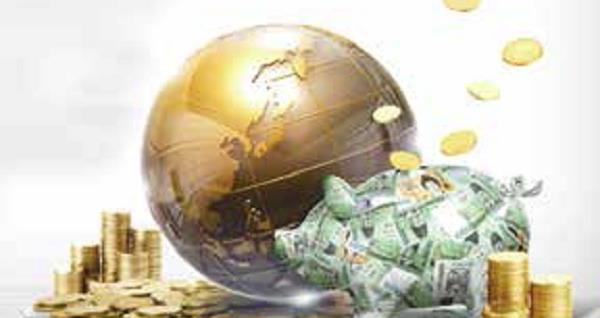
7. The Bible’s Teaching on Poverty and Christians’ Responsibilities in Supporting Poverty Alleviation Ministries
The Bible mentions more than 300 verses about poverty or social justice, showing that God is a God who cares for orphans, widows, the poor, and the disadvantaged. Therefore, these are both the responsibility of Christians and the way to blessing.“Whoever shows mercy to the poor lends to the Lord, and the Lord will repay him for his good deed.” (Proverbs 19:17) The Bible has established a poverty relief system since the book of Exodus. People in God's family are required to take care of their poor brothers, not to bully the weak, and not to bend the integrity; during harvest, they must leave some crops or fruits for the poor who glean; if their brothers When you become poor and need something, you should help him or even invite him to live with you (refer to Leviticus 19:10 and 25:35).“You shall not mistreat a hired servant who is needy or needy, whether he is your brother or a sojourner in your city.” (Deuteronomy 24:14)God even said:“If you will obey the voice of the LORD your God and be careful to do all these commands that I command you today, there will be no poor among you.” (Deuteronomy 15:4)
But there will never be an end to the poor in the world, so we must always help the poor."There will never be an end to the poor in the land; therefore I command you, Loose your hand from your brothers who are poor and needy in the land." (Deuteronomy 15:11)The Lord Jesus also mentioned:"For the poor will always be with you, but I will not always be with you." (John 12:8)

▲We should always give a helping hand to the poor, and help those who are lacking.
As mentioned above, to take care of the poor, the government alone is not enough because the government has limited financial resources. The church and Christians have the responsibility to participate in the work of supporting the poor and caring for the vulnerable, so that we can become angels of love and blessed examples. In addition to donating money, you can also participate in volunteer work to help poor families obtain additional resources (such as subsidies from the government and social groups). You can also teach poor families how to manage money according to biblical principles, and try to prepare budgets and control expenditures with limited resources. Reduce financial stress, increase income, and ultimately escape poverty.

▲The government’s financial resources are limited, and churches and Christians have the responsibility to participate in helping the poor and taking care of the vulnerable.
(Image source: http://www.gxte.gov.cn/Item/Show.asp?m=1&d=6365)
基督徒奉獻給慈善事工的比率還是很低。美國人過去幾十年來,遵行什一奉獻的人口只有5%至7%,而所有對慈善機構(包括宗教團體)的捐獻總值只約達國內總生產(GDP)的2%,大多是有宗教信仰的人奉獻。18 捐獻給慈善機構的家庭中,將近四分之三的家庭是捐給與宗教有關的機構,約40%的家庭給教會,而其他非教會的非營利機構也多數有宗教背景,可見有宗教信仰的人對於捐獻還是比較慷慨,也是好現象,但仍有加強的空間。除了對教會及福音機構奉獻之外,基督徒也應該多捐贈給照顧弱勢族群的慈善機構,特別是基督教的慈善機構。19
Notes
1. National Poverty Center: Poverty in the United States, Frequently Asked Questions, www.npc.umich.edu/poverty/
2. US poverty rises despite economic recovery, www.reuters.com/article/2013/09/17/us-usa-economy-poverty-idUSBRE98G0PN20130917
3. Taiwan United Daily News 2-26-2014
4. The Economist: China's poor World-class poverty (www.ltaaa.com/wtfy/7853.html)
5. World Bank: go.worldbank.org/4DO5SXV2H0
6. World Bank: World Development Indicators 2013, p2
7. World Bank: Poverty Overview, www.worldbank.org/en/topic/poverty/overview
8. World Bank: The State of the Poor: Where Are The Poor, Where Is Extreme Poverty Harder to End, and What Is the Current Profile of the World's Poor? Economic Premise, 10/2013. ( siteresources.worldbank.org/EXTPREMNET /Resources/EP125.pdf)
9. World Bank: Poverty Overview, www.worldbank.org/en/topic/poverty/overview
10. AP: Income inequality: Top 1 percent took record share of 2012 US income, 9/10/2013, www.oregonlive.com/today/index.ssf/2013/09/income_inequality_top_1_percen.html
11. en.wikipedia.org/wiki/Homelessness_in_the_United_States. 2013 numbers are available at www.nytimes.com/2013/11/22/nyregion/january-tally-of-homeless-population-found-13-jump-in-city-us-data-say.html?_r=0
12. Homelessness/Poverty Stats, www.statisticbrain.com/homelessness-stats; source: National Law Center on Homelessness and Poverty.
13. Fang Xiaoding: Overview of homeless people in Taiwan and social controversies, Taiwan Legal Aid Foundation, Legal Aid Newsletter Issue 32, www.laf.org.tw/tw/b3_1_2.php?msg1=34&msg2=404&PHPSESSID=afnppvpqt78jppggomvk3e1lu0
14. Linda Gorman, Why Poverty Persists, National Bureau of Economic Research, www.nber.org/digest/jun06/w11681.html
15. en.wikipedia.org/wiki/Financial_literacy
16. 參見Financial Capability in the United States, 2012 Report of National Findings, by FINRA Investor Education Foundation, www.usfinancialcapability.org/downloads/NFCS_2012_Report_Natl_Findings.pdf
17. See www.crown.org and www.crown.org.tw
18. Giving USA: www.charitynavigator.org/index.cfm?bay=content.view&cpid=42
19. Nearly three-quarters of household charitable giving goes to organizations with religious ties, new study finds, www.philanthropy.iupui.edu/news/article/jumpstart

